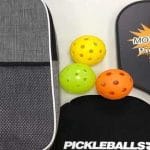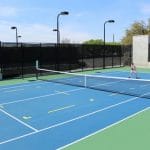When it comes to choosing the best material for your pickleball paddle, there are a few factors to consider. Generally, pickleball paddles are made from four primary materials: wood, composite, graphite, and aluminum. Each material has its own advantages and disadvantages, so it ultimately comes down to personal preference.
Wooden paddles are the most affordable, but they are the heaviest and least durable of the four materials. Composite paddles offer a good combination of power and control, but they can be more expensive. Graphite paddles are lightweight and provide excellent power, making them a good choice for competitive players.
Finally, aluminum paddles are the most durable and provide a lot of power, but they can also be the most expensive. Ultimately, the best material for your pickleball paddle depends on your skill level, playing style, and budget.
What is the Best Material for a Pickleball Paddle?
The best material for a pickleball paddle is typically graphite or composite. These materials offer a good balance of power, control, and durability, making them popular choices among players of different skill levels.
Factors to Consider When Choosing Material
When it comes to choosing the best material for a pickleball paddle, several factors come into play. Firstly, you need to consider the weight of the paddle. If you’re a beginner, it’s better to opt for a lighter paddle that is easier to maneuver.
However, if you’re an experienced player, a heavier paddle can help you generate more power in your shots. Another important factor is the material used to make the paddle. The most common materials used for pickleball paddles are graphite, composite, and wood.
Graphite paddles are lightweight and provide excellent control, making them a great choice for players who prioritize precision over power. Composite paddles are slightly heavier but offer a good balance of control and power. Wood paddles are the heaviest of the three but are often preferred by traditionalists and players who value durability over anything else.
Ultimately, the best material for your pickleball paddle will depend on your personal preferences and playing style.

Comparison of Common Materials: Graphite, Wood, Aluminum, Polymer
When it comes to choosing the best material for a pickleball paddle, there are several options to consider: graphite, wood, aluminum, and polymer. Graphite paddles are a popular choice among intermediate and advanced players, as they are lightweight, durable, and offer great control. However, they can be more expensive than other materials and may not provide enough power for beginners.
Wood paddles, on the other hand, are a classic choice that offer a traditional feel and good control, but they tend to be heavier and may not be as durable over time. Aluminum paddles are lightweight and offer good power, but they can be noisy and less comfortable to hold. Polymer paddles are a newer option that offer a softer feel and good control, but they may not be as durable and tend to be heavier than other materials.
Ultimately, the best material for a pickleball paddle will depend on your personal preferences and playing style, so it’s important to try out different materials and styles to find the one that works best for you.
Graphite Pickleball Paddles
When it comes to choosing the best material for a pickleball paddle, graphite is often the top choice. Graphite pickleball paddles are favored by many players because of their light weight and durability. They are also known for their ability to provide excellent power and control, making them ideal for players of all skill levels.
Graphite paddles have a unique texture that allows for a good grip, even in hot or humid weather. They are also resistant to wear and tear, which means they can last for years with proper care. Additionally, graphite paddles are affordable and widely available, making them a great choice for players looking for a quality paddle that won’t break the bank.
Overall, if you are looking for a reliable and versatile pickleball paddle, go for a graphite one.
Advantages of Graphite
Graphite is a material that has become increasingly popular in the pickleball world thanks to its unique properties compared to other paddle materials. Graphite pickleball paddles have a number of advantages that make them a popular choice among players. For one, they tend to be much lighter than other materials, which can improve a player’s speed and reaction time on the court.
They are also known for their durability, which can save players money in the long run since they won’t have to replace their paddle as frequently. Another benefit of graphite paddles is their stiffness, which can provide more power and better control during play. Plus, the material itself is naturally shock-absorbent, which can make for a more comfortable playing experience overall.
All of these benefits make graphite paddles a popular choice for players looking to improve their gameplay and performance on the court.
Disadvantages of Graphite
Graphite has been a popular material for pickleball paddles due to its lightweight and durable qualities. However, there are also some disadvantages to using graphite paddles. One of the major downsides is that they tend to be more expensive than other materials like wood or aluminum.
Another issue is that graphite can be brittle and more prone to chipping or cracking compared to other materials. In addition, graphite paddles may not have the same level of touch or feel on the ball as a wooden paddle, which can make it difficult for players looking for more precision and control. While graphite paddles certainly have their advantages, these disadvantages should be taken into consideration when selecting the right paddle for your game.
Wood Pickleball Paddles
When it comes to choosing the best material for a pickleball paddle, the debate can get quite heated amongst players. However, one material that has been around since the beginning is wood. Wood paddles are known for their classic look and feel, and some players swear by them.
They offer a traditional experience that many players find appealing, and they’re durable enough to withstand heavy use. One of the biggest advantages of wood paddles is that they’re relatively inexpensive, making them a great option for anyone who doesn’t want to break the bank. They’re also more environmentally friendly than some of the other materials used for paddles, which is a consideration for many players.
However, it’s worth noting that wood paddles do have some downsides. They’re typically heavier than composite or graphite paddles, which can make them more difficult to maneuver. They can also warp or crack over time, especially if they’re not cared for properly.
Ultimately, the decision to use a wood pickleball paddle comes down to personal preference. If you’re interested in experiencing the game the way it was originally played, a wood paddle might be the right choice for you. Just be sure to take good care of it, and remember that there are plenty of other materials out there that may suit your needs better.
Advantages of Wood
Advantages of Wood When it comes to pickleball paddles, there are various options available in the market. However, wood paddles have their own set of advantages that make them a favorite among players. One of the key benefits of using a wood paddle is that it offers greater control and accuracy when playing.
The natural surface of the wood provides a better grip, allowing players to make precise shots and control the ball better. Moreover, wood paddles are more durable than their synthetic counterparts and can withstand repeated use and even the occasional accidental drop. Additionally, wood paddles have a unique feel and sound that many players find more satisfying than synthetic materials.
The weight of wood paddles is also a plus as they provide a good balance between power and control. In summary, if you are looking for a durable, precise, and satisfying paddle to improve your game, wood paddles are definitely worth considering.
Disadvantages of Wood
While wood is a popular choice for pickleball paddles due to its natural feel and aesthetics, there are some disadvantages that players should consider. One major issue is durability. Wood paddles tend to be less durable and more prone to breaking or warping than other materials like graphite or composite.
They are also heavier, which can cause fatigue during longer matches. Additionally, wood paddles may not offer the same level of power or control as other materials, which can affect a player’s performance on the court. It’s important to weigh the pros and cons before deciding whether a wood pickleball paddle is the right choice for you.
Aluminum Pickleball Paddles
When it comes to choosing the best material for a pickleball paddle, aluminum is a popular option that many players prefer. Aluminum paddles are known for their durability and ability to withstand wear and tear. They are also lightweight, offering players an easy maneuverability on the court.
Additionally, they tend to have a larger sweet spot, which means hitting the ball in the right spot is easier and provides more consistent shots. Additionally, aluminum pickleball paddles have a softer feel and less of a ping sound when the ball is hit. So if you’re looking for a paddle that is both durable and easy to handle, an aluminum pickleball paddle may be a great option for you.
However, keep in mind that each player has their own playing style and preferences. It’s important to try out a few different options before making a final decision. After all, the right paddle can make all the difference in how well you perform on the court.
Advantages of Aluminum
Aluminum is a fantastic material with a range of advantages, especially when it comes to sports like pickleball. In particular, aluminum pickleball paddles are becoming increasingly popular due to their lightweight yet durable construction. Aluminum is incredibly strong, yet it is also highly malleable, meaning that it can be shaped into a range of different sizes and shapes.
This makes it perfect for creating sports equipment like paddles, which require a balance of strength and agility. Additionally, aluminum paddles are resistant to rust and corrosion, ensuring they will last for years even with heavy use. Overall, the benefits of aluminum paddles are hard to ignore – they are lightweight, durable, and versatile, making them the ideal choice for serious players looking to improve their game.
Disadvantages of Aluminum
If you’re in the market for a new pickleball paddle, you may have come across aluminum paddles. While they do have some advantages, such as being lightweight and durable, they also come with some disadvantages. One of the biggest drawbacks of aluminum paddles is their lack of control.
Because aluminum isn’t as flexible as other materials, it can be difficult to get the ball exactly where you want it. Additionally, aluminum paddles tend to have a harsher feel upon impact, which some players find uncomfortable. Another issue that some players have with aluminum paddles is their lack of power.
If you’re someone who likes to hit the ball hard, you may find that an aluminum paddle doesn’t give you the same amount of oomph as other materials might. Overall, while aluminum paddles may be a good option for some players, they’re not for everyone. It’s important to weigh the pros and cons before making a decision on which paddle to purchase.
Polymer Pickleball Paddles
When it comes to choosing the perfect pickleball paddle, it all boils down to the material. And nowadays, polymer is the most popular option among professional and amateur players alike. The reason why polymer is an excellent choice is that it strikes the perfect balance between power and control.
It is a durable material that can withstand the continuous pounding of balls without losing its shape or structure. Polymer paddles also provide a great feel and feedback upon impact, ensuring that you can get the most out of your swings. Another significant advantage of using polymer paddles is its affordability.
You can find quality polymer paddles at reasonable prices, making them accessible for players of all skill levels. So if you’re looking for a reliable and high-performing pickleball paddle, go for one that’s made of polymer material, and you won’t regret it!
Advantages of Polymer
Advantages of Polymer in Making Paddleball Paddles Polymer, a synthetic material, has numerous advantages over other materials, including durability, longevity, and lightweight properties. Its high resistance to impact, moisture, and temperature makes it a popular choice for manufacturing pickleball paddles. Polymer pickleball paddles are also resistant to scratches and dents, ensuring their longevity and durability.
Additionally, the polymer’s lightweight and easy-to-handle properties make it easier for pickleball players to handle and swing their paddles. With its high versatility and compatibility, the manufacturing of polymer pickleball paddles offers a unique opportunity for players to enjoy a quality playing experience while ensuring optimal performance. In conclusion, the use of polymer in manufacturing pickleball paddles offers numerous advantages that make it stand out as a superior choice over other materials in the market.
Disadvantages of Polymer
Polymer pickleball paddles have their advantages, but they also come with some downsides. For starters, they tend to be heavier than other types of paddles, which can be a disadvantage for players who prefer lighter equipment. Additionally, some players find that polymer paddles don’t offer as much “feel” or control as wood or composite paddles.
This can make it more difficult to place shots accurately. Another issue with polymer paddles is that they are not always as durable as other materials. While they may offer good value for the price, they may not last as long as more expensive options.
Overall, there are pros and cons to using a polymer paddle in pickleball, and players should carefully consider their own needs and preferences before making a purchase.
Choosing the Right Material for You
If you are looking for a pickleball paddle material that offers a great balance between power and control, polymer is a great option to consider. Polymer pickleball paddles are lightweight and versatile, making them ideal for players of all skill levels. Polymer paddles offer excellent control and precision, allowing players to place the ball exactly where they want it.
Additionally, they provide ample power without being too heavy or unwieldy. With a polymer paddle, you can enjoy a comfortable grip, a responsive surface, and a durable design that can withstand even the most intense games. So if you’re looking for a high-quality pickleball paddle that can help you elevate your game, consider a polymer option.
Conclusion
Well, after much deliberation and trial and error, it seems that the answer to the age-old question of what is the best material for a pickleball paddle is…
it depends. Each player has their own unique playing style and preferences, so the best material for one player may not be the best for another. Some may prefer the lightweight and maneuverability of a graphite paddle, while others may prefer the durability and power of a polymer or composite paddle.
It’s all about finding the paddle that feels comfortable in your hand and gives you the confidence to dominate the pickleball court. So, in summary, the best material for a pickleball paddle is the one that helps you play your best game and leaves your opponents in a pickle!”
FAQs
What type of material is commonly used for pickleball paddle?
The most commonly used materials for pickleball paddles are graphite, composite, and wood.
How does the material affect the performance of a pickleball paddle?
The material of the pickleball paddle affects the paddle’s performance in terms of power, control, and maneuverability. Graphite paddles offer more power, composite paddles offer a balance of power and control, while wooden paddles offer more control.
Are there any drawbacks to using a graphite pickleball paddle?
Graphite paddles are known for their power and lightweight, but they can be harder on the arm due to the stiffness of the material. They are also typically more expensive than other materials.
What is the durability of a composite pickleball paddle?
Composite paddles are known for their durability and can last for a long time with proper care. They are also resistant to outdoor elements such as moisture and sun exposure.










